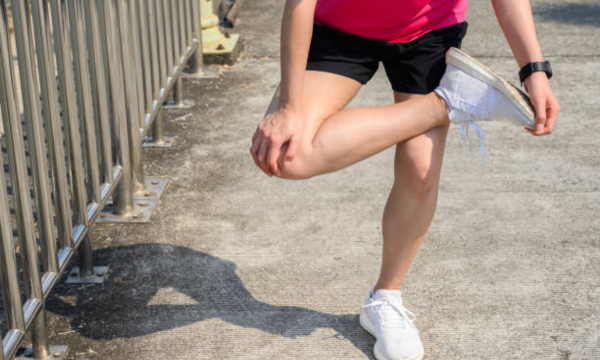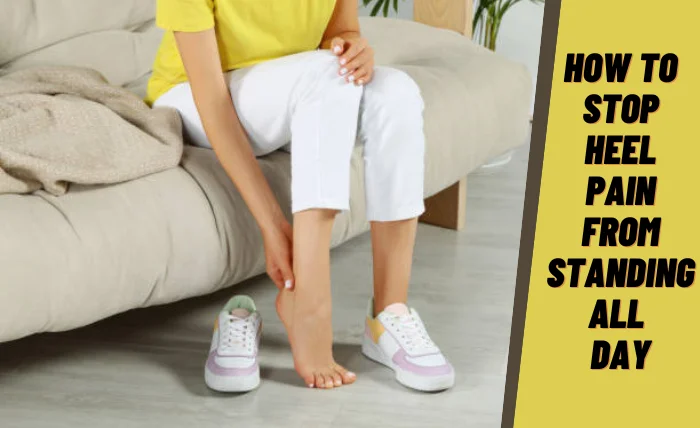Are you tired of ending your day with aching heels from standing all day? You’re not alone. Many of us face this relentless discomfort, but there’s good news! You can take simple, effective steps to alleviate and even prevent this pain. Imagine finishing your workday with feet that feel as fresh as they did in the morning.
Intrigued? Our guide will show you how to transform this dream into reality, with practical tips and expert advice. To heel pain and hello to comfort with our straightforward, fluff-free advice. Keep reading to discover how to stop heel pain from standing all day and reclaim your comfort.
Heel Pain From Standing All Day an Overview

Standing all day can lead to heel pain, a common issue for many. Let’s dive into the causes, symptoms, and when to seek help. With clear steps, you can manage and prevent this discomfort.
Causes of Heel Pain
Prolonged standing puts stress on your feet. It can change foot anatomy over time. Conditions like plantar fasciitis and heel spurs often result from this constant pressure. These issues arise when the foot’s support structures become overwhelmed.
How Prolonged Standing Affects Foot Anatomy
Standing for long periods can harm your feet. It strains muscles, ligaments, and bones. Over time, this strain can lead to changes in how your foot is structured. It can make existing foot problems worse.
Common Conditions Associated
Plantar fasciitis and heel spurs are common among those who stand a lot. Plantar fasciitis involves inflammation of the foot’s arch support. Heel spurs are growths of bone on the heel. Both cause heel pain.
Recognizing Symptoms
Heel pain signs include sharp pain in the foot’s bottom, especially in the morning. Swelling and aching in the heel area are also common. These symptoms can signal conditions like plantar fasciitis.
When to Seek Professional Help
If heel pain lasts more than a week or gets worse, see a doctor. Early treatment can prevent more serious issues. A foot specialist can offer tailored advice and treatment options.
Preventative Measures to Avoid Heel Pain
Heel pain from standing all day is a challenge, but not one without solutions. Let’s explore some basic strategies to keep your feet happy and pain-free.
Choosing the Right Footwear
Supportive shoes are key to preventing heel pain. Look for shoes with a firm heel, ample arch support, and enough room to move your toes. For those in healthcare or retail, shoes designed for long periods of standing can make a big difference. Each job has its shoe needs, so choose wisely.
The Role of Orthotics
Orthotics can be a game-changer for heel pain. They support your foot where it needs it most. You can find them ready-made at stores or get them custom-made by a specialist. Both types help distribute pressure evenly across your foot, easing the strain on your heels.
Proper Foot Hygiene and Care
Daily foot care is essential. Wash your feet daily, dry them well, especially between the toes, and moisturize to keep the skin supple. Trim your nails straight across to avoid ingrown toenails. These simple steps can prevent many foot problems before they start.
Effective Strategies to Relieve Heel Pain
Heel pain doesn’t have to be the price you pay for standing all day. Let’s dive into some effective strategies to keep that pain at bay.
Stretching and Strengthening Exercises
A mix of stretching and strengthening exercises can target heel pain. Start with calf stretches and toe curls to improve flexibility. Then, add exercises like heel raises to strengthen the muscles around your heel. Doing these daily can support your foot’s health and reduce pain.
Breaks and Movement Variation
Taking short breaks can reduce heel strain. Try to sit or walk every hour to change the pressure on your feet. Adjust your workspace to allow for different postures. A good standing mat and supportive shoes can also help maintain a healthy standing posture.
Home Remedies and Self-Care
Epsom salt soaks can soothe sore heels. Fill a basin with warm water, add Epsom salt, and soak your feet for relief. Gentle massages with essential oils can also help. Regular foot care, including moisturizing and gentle stretching before bed, will keep your feet in top shape.
Advanced Treatments for Persistent Heel Pain
When heel pain persists despite your best efforts, it might be time to consider advanced treatments. Let’s explore when to seek help and what modern medicine offers.
When to See a Specialist
If heel pain does not improve with home care, see a specialist. Signs you need professional help include constant pain, swelling, and difficulty walking. Podiatrists and orthopedists are experts in foot health. They can diagnose and treat your heel pain.
Overview of Specialists Who Can Help
Podiatrists focus on foot and ankle issues. Orthopedists specialize in the entire musculoskeletal system. Both can offer treatments for heel pain. They will choose the best approach based on your specific condition.
Modern Medical Interventions
For severe heel pain, there are many treatment options. Non-invasive methods include physical therapy and custom orthotics. In some cases, surgery might be necessary. Techniques vary from minimally invasive to more complex procedures, depending on the issue.
Heel Pain Treatment and Rehabilitation
Medical science constantly evolves. New treatments for heel pain include shockwave therapy and laser treatments. These can speed up healing and reduce pain without surgery. Rehabilitation programs also use the latest research to improve recovery times.
Seeking advanced treatment for persistent heel pain can lead to relief and a return to normal activities. Specialists offer a range of options tailored to your needs, using the latest in medical advancements.
Lifestyle Adjustments for Long-Term Relief
Heel pain from standing all day can often be managed with some lifestyle adjustments. Let’s explore how diet, weight management, and workplace ergonomics can play a crucial role in providing long-term relief.
Diet and Nutrition
Eating foods rich in calcium, vitamin D, and magnesium supports bone and joint health. These nutrients help keep your feet strong. Omega-3 fatty acids, found in fish and flaxseeds, can reduce inflammation. Supplements like glucosamine may also benefit foot and heel health by supporting cartilage.
Weight Management
Extra weight puts more strain on your feet, leading to pain. Understanding this impact is key to managing heel discomfort. Adopting a balanced diet and regular exercise helps in weight control. These steps reduce the burden on your feet and can alleviate heel pain.
Workplace Ergonomics
Setting up a standing workstation correctly can prevent foot and heel pain. Ensure the floor is even and consider using an anti-fatigue mat. These mats reduce stress on your feet. Also, explore alternative seating options like sit-stand stools. They allow periodic rest for your feet while maintaining productivity.
Bottom Line
How to stop heel pain from standing all day involves a blend of preventative measures, effective relief strategies, and lifestyle adjustments.
From choosing the right footwear and incorporating breaks into your day to seeking advanced treatments when necessary, these steps can significantly improve your comfort.
Embrace these changes to ensure your feet remain pain-free, allowing you to stand all day without discomfort.

